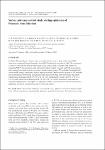Survey and case-control study during epidemics of Puumala virus infection
Winter, C. H.
Brockmann, Stefan
Piechotowski, I.
Alpers, Katharina
Heiden, Matthias an der
Koch, Judith
Stark, Klaus
Pfaff, Günter
In Baden-Wuerttemberg, a federal state in south-west Germany, a large outbreak of 1089 laboratory-confirmed human Puumala virus (PUUV) infections occurred in 2007. We conducted a survey to describe the disease burden and a case-control study to identify risk factors for acquiring PUUV. Case-patients were interviewed about clinical outcome and both case-patients and randomly recruited controls were interviewed about exposure. We calculated matched odds ratios (mOR) using a conditional logistic regression model. Multivariable analysis of 191 matched case-control pairs showed that case-patients were more likely than controls to have seen small rodents/their droppings (mOR 1·9, 95% CI 1·2–3·0), cleaned utility rooms (mOR 1·8, 95% CI 1·0–3·4) and visited forest shelters (mOR 3·9, 95% CI 1·1–14·3). Two thirds of case-patients required hospitalization. During PUUV epidemics rodent control measures and use of protective equipment should be considered in utility rooms and shelters.
No license information

